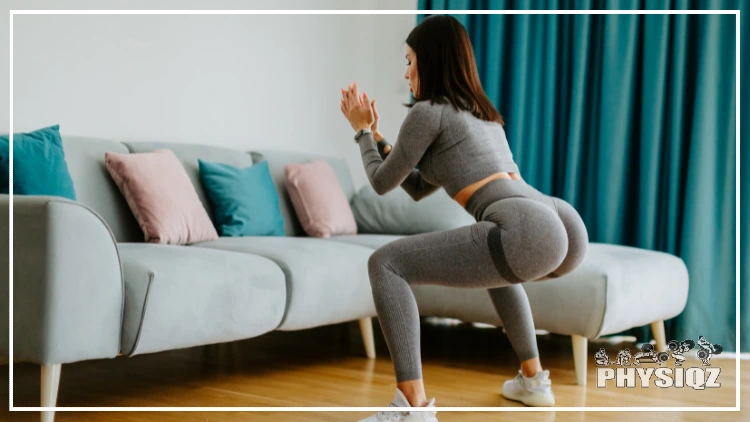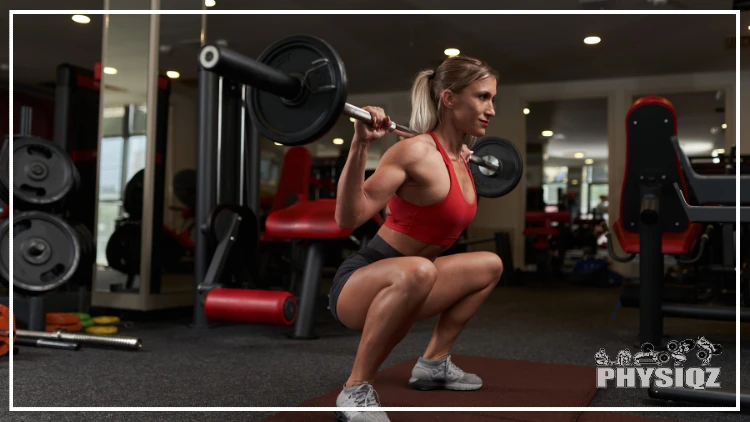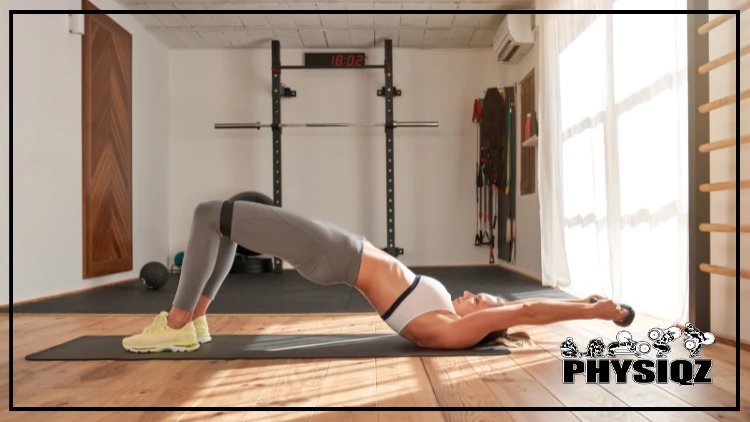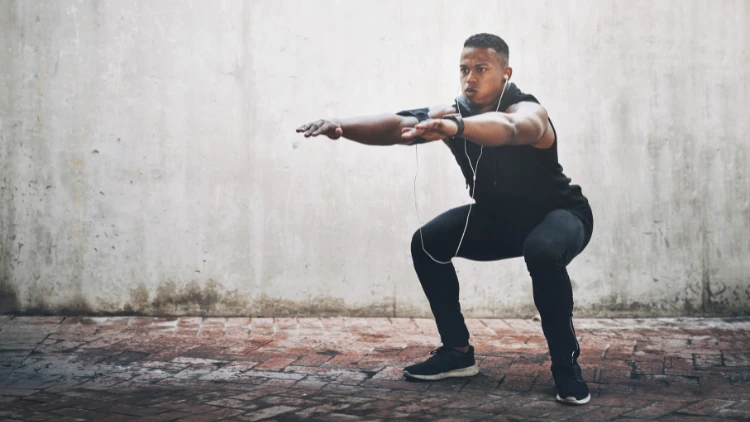
This workout plan is tailored to target the upper gluteal area, incorporating a range of the 14 specific exercises known to effectively tone and sculpt the upper buttocks. By following this plan, you can ultimately achieve a fuller and more shapely rear end.1
But before we delve into the actual workout routine, let’s take a look at the best upper glute workout and how to do them at home, or in the gym so you can kiss that flat booty goodbye.
What are the Exercises to Lift Your Buttocks? (Best Gluteus Maximus Workout to Enhance Upper Buttocks)
There are several effective lower body exercises that contribute to muscle firmness, buttock lifting, and reducing the appearance of flatness in the upper buttocks.
With that being said, some exercises are better to incorporate than others! Below is a detailed list of exercises that are guaranteed to lift the buttocks, target the upper glute muscles, and help define and tone the posterior region.
These exercises can seamlessly integrate into a lifter’s 6-week powerlifting program or stand alone as the foundation for a personalized workout routine.
Sometimes buttocks sculpting isn’t the only goal. Lifters seeking to discover effective methods for achieving rapid weight loss, such as quick ways to get skinny, can benefit from incorporating these exercises, as they facilitate muscle growth and calorie burning during each workout. The drop in body fat, especially around the waist, will further help to lift and increase the appearance of buttocks size.
1. Cable Glute Kickbacks
The glute kickback exercise is a movement that specifically targets all the glute muscles of the buttocks, especially the gluteus maximus.
This provides the glute with a tight and lifted appearance, and helps to rid weight lifters of the dreaded flat upper butt. Due to the dynamic movement of this exercise, glute kickbacks will also engage the core and aid in the development of hip stability.
To do a kickback, attach the ankle to the cable with an ankle cuff. Lifters will face the machine with their feet hip or shoulder width apart with slight tension on the cable.
Next, flex the hips so that the chest is parallel-ish to the floor keeping a tight core. From this position, lift the leg straight back, keeping the knees slightly bent.
Try to hold this position for a moment before slowly lowering the leg back down to the resting position. Complete the amount of desired reps before switching to the other leg.
If you’d prefer, you can try the seated machine instead. That’s perfectly fine. One study found no difference between the use of either methods when it came to strength and fitness outcomes.2
2. Machine Hip Abduction
Machine hip abduction targets the outer muscles of the hips, specifically called the gluteus medius and gluteus minimus. These are located in the upper buttocks region and are ideal for lifting and toning the posterior.
The machine hip abduction uses a seated position with the outside of the knee resting against the pads of the equipment. Because this exercise is seated, the glute muscles can be isolated to really tone and lift the muscles.
This does not require balance, making it more difficult to cause injury. Therefore, it is a good exercise for beginners and those who struggle with stability.
First, sit on a hip abduction machine with the feet resting on the footplate, knees resting against the pads, and hands placed on the handles located at the sides of the machine.
Next, lifters will open their legs away from the body, which is called abduction. Lifters should attempt to engage in full range of motion before bringing the legs back towards midline.
Must-Try Workouts for Upper Glute Strength & Size (How to Build Your Upper Glutes)
To achieve muscular hypertrophy, focusing on increasing muscle size and strength, it’s essential to incorporate the exercises outlined below for the most effective upper glute training routine.
These movements will target all glute muscles, as well as other muscles in the leg to give the appearance of a well sculpted posterior.
Using weighted exercises can increase the risk of injury.
Lifters experiencing discomfort in the upper thigh and groin area should limit their lower body activity until they address the cause of pain in the upper thigh and groin area. They should also be mindful of symptoms related to sports injuries.
3. Back Squats
Squats are a very popular exercise that targets all the glute muscles, in addition to the hamstrings or “hammies” and quadriceps or “quad” muscles located on the back and front of the upper thigh respectively. Squats are the ideal exercise for building muscle size and strength, especially in the upper glute area of the body.
Squats variations can include front squats which are great for targeting the quadriceps or “quad” muscles in the thigh, back squats in which weight is distributed with a barbell across the muscles of the upper back and shoulders, and sumo squats with toes facing outwards to target the inner thigh or hip adduction muscles.

Source: Slatan via Canva.com3
Among all squat variations, the back squats stand out as the most effective for enhancing overall strength and size of the gluteal muscles. It’s a glute and hamstring dominant exercise, and is key to incorporate to build the buttocks.
Lifters who want to maximize their strength and size should aim to complete a low amount of reps per set with a high amount of weight, so loading up the barbell with a heavy but appropriate amount of weight will help lifters to best reach their glute strength and size goals.4
Furthermore, squatting has additional benefits such as being a compound movement meaning it involves multiple joints. This leads to improved stability and balance outcomes while targeting multiple muscle groups at once.
To back squat, try using a squat rack or smith machine to add weight to. Make sure the bar is resting slightly below shoulder height.
Weightlifters often debate the merits of high bar vs low bar squat placement, so it’s essential to delve into the distinction to determine which suits their needs best.
Start with feet hip-width apart with the hands lifted to aid in the support of the squat bar. Next, lower the body as if until the thighs are parallel to the floor and the knees are flexed at 90 degrees. With the weight placed in the heels, the chest should remain facing upward for postural stability.
Lifters will then stand back up to the starting position, and repeat until the number of reps a set calls for is complete.
4. Hip Thrusts
Hip thrusts are ideal for those wanting to build both strength and muscle size in the glutes. It is a compound exercise, which allows for multiple muscle groups to be targeted to maximize the efficiency of a workout.
Because hip thrusts engage the muscles that support the hip joint, this exercise will lead to increased blood flow to this region.
This provides the surrounding ligaments and tendons with nutrients leading to lower instances of hip injury and lower back pain.

Source: Philippe Degroote via Canva.com5
To perform a hip thrust, a weight lifter will start by sitting on the ground with their upper back region placed firmly against a bench or similarly elevated surface. Next, place a weighted barbell or dumbbell across the hips.
The knees will be placed at a 90-degree angle of flexion, with feel placed flat on the ground. Next, the lifter will push through their heels and squeeze the glute muscles to raise their hips.
This will cause the body to form a straight line from the shoulders to the knees that is parallel to the floor. Lifters will slowly lower their hips back to the starting position and then repeat for the amount of reps required for muscle fatigue.
5. Deadlifts
Deadlifts are a body builder’s staple for a reason. Not only does this exercise target all the muscles in the glutes; it also engages the hamstrings located in the back of the thighs, and back muscles including the lats and traps.
Rest assured, incorporating squat and deadlift routine on the same day is perfectly acceptable in workout programs.
Much like squats, deadlifts are a compound exercise, which are important to use to achieve results. In fact, research shows that compound movements will significantly increase muscle strength as compared to simplified movement patterns.6
Furthermore, deadlifts can aid in the improvement of posture, helping to prevent posture related ailments and spine injuries down the line.
In order to perform the deadlift exercise, lifters should start by standing with their feet roughly hip-width apart and the toes pointing straight ahead or slightly turned outwards.
Next, lifters should place their hands on the barbell with an overhand grip with the palms facing downward or in supination. The knees should be slightly bent to lower the hips when grasping the bar, and the back should be straight.
Next, lift the barbell off the ground by extending the hip and knee joints. Make sure to squeeze the glutes or buttocks region of the body to really engage the muscle, and push the hips forward when entering into a standing position.
Carefully lower the bar to the ground by flexing the hips and knees while keeping the back straight.
When participating in compound exercises like those mentioned, it’s crucial to integrate a protein shakes diet plan to optimize muscle growth and facilitate recovery.
Best Upper Glute Workout With Weights (Top Equipment for Toning Your Upper Glutes)
While most of the exercises discussed above are weighted or use resistance to engage the upper glute muscles, the exercise below is the best to use in combination with weights to build the upper glute muscles. Individuals seeking an effective upper glute workout should consider integrating this into their glute routine.
6. Back Extension or “Good Mornings”
This compound exercise is renowned for promoting muscle growth and targets the lower back, upper glutes, and hamstrings simultaneously. These muscles are part of what is referred to as the posterior chain, and can be engaged with back extension and deadlift exercises.7
It also helps with building core stability by engaging the deep muscles in the back and all the layers of the abdominals.
A lifter using the good morning exercise should start by standing with their feet hip or shoulder width apart and knees loosely bent. A barbell will be placed across the upper back with an overhand grip, similar to a back squat placement.
Next, with shoulders pulled back for erect spine posture, the lifter will flex at the hip joint while engaging the core and glute muscles.
The hips will hinge forward as the body is lowered towards the floor. Lifters should aim to complete full range of motion with the chest placed parallel to the ground. The lifter will then engage in hip extension to return to the start position.
How to Strengthen Your Upper Glutes Without a Gym
The glutes can prove to be the hardest muscle to grow, and many believe it’s unattainable to develop them without a gym. But the good news is that gym equipment is not necessary to build the upper glute muscles!
There are many exercises that can be done to work the legs and build the upper glute muscles without the help of fancy machines, squat racks, and heavy weights. Men and women without gym memberships are encouraged to utilize the body weight movements below to target this muscle group and maximize glute hypertrophy, or more simply put, muscle building.
Body Weight Movements To Build Glutes (No Equipment Glute Exercises)
Engaging in body weight exercise is a great way to target muscle groups while providing minimal stress on the joints involved in the movements utilized. Any of the exercises below can be completed with only body weight, making them ideal for those wanting to cure their flat bottom but with no gym equipment.
7. Body Weight Squats
Bodyweight squats effectively target all glute muscles for an excellent workout that focuses on the upper glutes, while also engaging the hamstrings, located at the back of the thighs, and the quadriceps, located at the front of the thighs. In addition to targeting the entire lower body, body weight squats will put less stress on the spine making them much less likely to cause an injury.

Source: PeopleImages via Canva.com8
To complete a bodyweight squat, simply stand with the feet hip-width apart and lower your body as if sitting back into a chair. Try to keep knees behind the toes and be sure to keep the weight in your heels during this movement.
Once the knees are flexed at 90 degrees, push back up to the starting position.
Research notes that varying foot angle can be used with good results, but reports increased risk of injury with overly narrow or wide stances.9
8. Fire Hydrants
This exercise specifically targets the gluteus medius muscle, which is located at the upper buttocks region, as well as the hip abductor muscles which are located on the sides of the buttocks. It can be used to help strengthen, build muscle size, improve overall tone, as well as engage the core for stability.
This exercise is performed in a quadruped position, meaning on all fours with hands and knees placed firmly on the ground to support the lifter’s bodyweight. Make sure the core is tight and engaged.
Next, the lifter should lift one leg out to the side, while keeping the knee and foot in roughly 90 degrees of flexion. The movement should resemble a dog lifting its leg to pee, hence the appropriately named exercise.
Slowly lower the leg back down to the starting position. Lifters can either alternate legs or complete all reps for one leg before moving on to the other.
9. Body Weight Glute Bridges
Glute bridges are an ideal body weight exercise that targets all three gluteal muscles that form the buttocks: the gluteus maximus, the gluteus medius, and the gluteus minimus. This exercise will improve glute size, shape, and tone these muscles and is ideal to incorporate when gym access is not feasible.
Along with adding muscle size and overall shaping, this exercise will increase hip and pelvic stability by strengthening the muscles around the hips and pelvis bones. As a result, posture will be noticeably improved while decreasing the instance of back pain and hip tightness.
To complete a glute bridge, lifters should lie on their back with their knees bent and feet completely flat on the ground.
Next, lift the hips into the air to full extension, squeezing your glutes or butt muscles at the top of the movement. Slowly lower the hips back down to the starting position before completing another rep.
Dumbbell Workouts for Glutes (For Both Women & Men)
Dumbbells’ glute exercises are easy to do and since dumbbells’ are so accessible, they can be done nearly anywhere. There’s countless variations of each exercise and many can be done with barbells too.
10. Dumbbell Lunges (Walking, Standing, or Reverse Variations)
Lunges are a great glute exercise to help build the upper butt region. Reverse lunges are a glute dominant movement and are ideal for building the upper glute muscles, whereas the standard forward lunge will be more quad dominant.
Walking lunges have their own set of benefits, as they require stability and balance due to the dynamic movement involved. For those wanting to build their buttocks, all variations will target the glute muscles, but reverse lunges might be best to try.
Understanding the muscles worked during walking, standing, and reverse lunges can assist you in targeting various muscle groups, keeping your workouts dynamic and engaging.
To complete a standard lunge, the lifter will step forward with one foot and lower their body until their thigh is about parallel to the ground. Next, they will push back up to the starting position and repeat with the other leg.
A reverse lunge will look the same, however the step will be backwards rather than forwards.
11. Dumbbell Step Ups
Step ups are a body weight movement that can help to both build and strengthen the upper glute muscles, in addition to the quads and hammies in the thigh, and the muscles in the calves. Additionally, this exercise can also improve overall balance and coordination because it is a complex dynamic movement.
It can also be a form of aerobic exercise, or exercise requiring oxygen to complete, and improves cardiovascular fitness and endurance.
All that is required for step ups is a stable, elevated surface such as a bench, chair, or steps and a pair of appropriately weighted dumbbells. To complete this exercise, place one foot on the elevated surface and simply step up onto the surface.
Lifters should be pushing through their heels to lift the body upwards. Step back down with the same leg and then repeat these actions with the other leg.
Some research suggests that lateral or side moving step ups result in more glute activation than forward facing step ups, so using this variation may be beneficial to further target the buttocks muscles.10
Exercises for Glutes Using Bands (Banded Upper Glute Workout Exercises)
Bands are a fantastic alternative to dumbbells due to being cost efficient and easy to travel with.
They also provide a great deal of resistance, upping the intensity of many of the body weight exercises detailed above. Make sure to try out banded upper clue exercises to cure that flat upper butt.
12. Resistance Band Hip Abduction
Much like the aforementioned machine hip abduction exercise, this exercise targets the hip abductors and more importantly, the gluteus medius and gluteus minimus of the upper buttocks. Because dynamic movement is being used, this will also improve overall stability and balance while also engaging the core.
For this exercise, use a resistance band placed around the legs above the knee. The tension should be taught when standing with feet shoulder length apart.
Lifters will start with their feet together and hands placed on hips. Next, they will slightly bend the supporting leg and lift the other leg laterally, or to the side.
This is called abduction. Try to hold the position at full abduction for a brief moment before lowering the leg back down to the starting position.
Complete the amount of reps necessary before repeating on the other leg.
Best Cardio Workout for Upper Glutes
There are machines and free weights designed for targeting the upper glutes, but incorporating cardio can effectively engage the glutes and stimulate their growth.
13. Jump Squats
Much like body weight squats, jump squats is a great workout that engages the muscles of the upper butt while also providing intense cardio. Simply add a vertical jump to the squat steps detailed above before returning to the start position.
14. Stair Stepper
This is an intense cardio workout that targets the butt to build the glutes for pristine upper buttock development.
This is very similar to the step up exercise but with consistent cardio to target overall cardiovascular health. The intensity can be varied to meet whatever fitness goals a lifter has in mind.
3 Upper Glute Training Programs for Building Buttocks (Discover How to Develop a Shelf on the Upper Glutes)
The following are great glute programs to incorporate and any one of these routines should be used between two to three times a week, with ample rest days in between workouts to maximize recovery. For those seeking a downloadable program to shape their booty, there’s also a glute-building workout plan PDF accessible.
Program 1: Booty Blasting Routine
This program includes excellent lower body workouts for women, focusing on muscle growth and overall toning. The exercises incorporated consist of hip thrusts, squats, a deadlift workout, back extensions, and split squats.
To encourage lean muscle building, lifters should aim for 4 sets X 12 reps. Then, each workout they should try to increase the reps, sets, weight, or notice that it’s become easier to do 4×12 before moving up in one of those three ways. This is what’s called progressive overload.
Program 2: Ultimate Glute Workout With the Glute Guy
For those looking to build muscle quickly, particularly in the glutes, this workout plan for skinny guys to build muscle fast is the perfect program. Exercises used in this program include hip thrusts, back squat variation, deadlift variation, hamstring curls, front squat variations, and seated hip abduction.
Research shows that the high volume training is great for adding muscular size, but did not produce maximal results in strength performance.11 So to best increase muscle hypertrophy aim for a 3X6 scheme with high weight.
Program 3: HIIT + Cardio + Glute Blaster
Cardio is great for fat burning, and this program uses cardio based movements along with glute activating movements to help build the buttocks and glute shelf.
Exercises include jumping variations, lateral movement, floor work, squat jump variations, glute bridges and many more creative exercise patterns. This is a timed circuit so reps may vary depending on intensity.
Building the glutes can be hard, but with the exercises above achieving the ultimate sculpted buttocks is entirely possible.
Weightlifters aiming to enhance their upper glutes, lift and tone their buttocks, and overcome flatness can now rely on this top-notch upper glute workout to achieve their fitness objectives.
Frequently Asked Questions
How To Tell if the Glutes Are Being Worked?
Lifters will feel recruitment from the muscles located in the buttock when engaging in all the exercises noted above. To tell if the glutes are engaged, simply focus on the body part and make a note if the muscle is being squeezed.
How Often Can the Glutes Be Exercised?
This will depend on the intensity of the workout, because higher intensity requires more recovery time. In general, the glutes should only be targeted two or three times per week maximum with rest days in between.
How Long Until I See Glute Results?
The answer varies depending on the person, the frequency of exercise, protein intake, and body fat. Consistency is key, so make sure to stick to a workout program and results should be noticeable in as little as twelve weeks.
References
1avanti_photo. Canva. Accessed 19 April 2023. <https://www.canva.com/photos/MAEcgZOo8ao-woman-working-out-at-home/>
2Balachandran, A., Martins, M. M., De Faveri, F. G., Alan, O., Cetinkaya, F., & Signorile, J. F. (2016). Functional strength training: Seated machine vs standing cable training to improve physical function in elderly. Experimental gerontology, 82, 131–138. <https://doi.org/10.1016/j.exger.2016.06.012>
3Slatan. Canva. Accessed 19 April 2023. <https://www.canva.com/photos/MAEi6Cge-i8-fitness-woman-doing-barbell-squats/>
4Schoenfeld, B. J., Grgic, J., Van Every, D. W., & Plotkin, D. L. (2021). Loading Recommendations for Muscle Strength, Hypertrophy, and Local Endurance: A Re-Examination of the Repetition Continuum. Sports (Basel, Switzerland), 9(2), 32. <https://doi.org/10.3390/sports9020032>
5Degroote, Philippe. Canva. Accessed 19 April 2023. <https://www.canva.com/photos/MAFO1y-rsko-fit-woman-doing-hip-thrusts-in-gym/>
6Paoli, A., Gentil, P., Moro, T., Marcolin, G., & Bianco, A. (2017). Resistance Training with Single vs. Multi-joint Exercises at Equal Total Load Volume: Effects on Body Composition, Cardiorespiratory Fitness, and Muscle Strength. Frontiers in physiology, 8, 1105. <https://doi.org/10.3389/fphys.2017.01105>
7McAllister, M. J., Hammond, K. G., Schilling, B. K., Ferreria, L. C., Reed, J. P., & Weiss, L. W. (2014). Muscle activation during various hamstring exercises. Journal of strength and conditioning research, 28(6), 1573–1580. <https://doi.org/10.1519/JSC.0000000000000302>
8PeopleImages. Canva. Accessed 19 April 2023. <https://www.canva.com/photos/MAEIzDz61q0-get-your-squat-on/>
9Lorenzetti, S., Ostermann, M., Zeidler, F., Zimmer, P., Jentsch, L., List, R., Taylor, W. R., & Schellenberg, F. (2018). How to squat? Effects of various stance widths, foot placement angles and level of experience on knee, hip and trunk motion and loading. BMC sports science, medicine & rehabilitation, 10, 14. <https://doi.org/10.1186/s13102-018-0103-7>
10Mercer, V. S., Gross, M. T., Sharma, S., & Weeks, E. (2009). Comparison of gluteus medius muscle electromyographic activity during forward and lateral step-up exercises in older adults. Physical therapy, 89(11), 1205–1214. <https://doi.org/10.2522/ptj.20080229>
11Schoenfeld, B. J., Contreras, B., Krieger, J., Grgic, J., Delcastillo, K., Belliard, R., & Alto, A. (2019). Resistance Training Volume Enhances Muscle Hypertrophy but Not Strength in Trained Men. Medicine and science in sports and exercise, 51(1), 94–103. <https://doi.org/10.1249/MSS.0000000000001764>